NIST
NAC: Empowering NIST Compliance with Unparalleled Network Security and Access Control Strength
The National Institute of Standards and Technology (NIST) sets guidelines and standards to ensure robust cybersecurity practices. The Portnox Cloud plays a pivotal role in achieving NIST compliance. By enforcing granular access policies, Portnox's zero trust NAC ensures only authorized devices and users can access the network, mitigating risks of unauthorized access, data breaches, and insider threats. With continuous monitoring and real-time threat response capabilities, Portnox provides the necessary visibility and control to align with NIST's rigorous security requirements.

NIST compliance without the enterprise price tag

So long, shadow IoT. Precision IoT fingerprinting is here.
As a robust protocol that provides secure authentication and access management to networks, 802.1X is widely regarded as the gold standard for network access control. The Portnox Cloud has been designed to support any network that leverages 802.1X, giving you unprecedented flexibility, compatibility, and security when it comes to your network.
FAQs about NIST compliance
Related Reading
Try Portnox Cloud for Free Today
Gain access to all of Portnox's powerful zero trust access control free capabilities for 30 days!







